Louisiana
-
- What a Difference a Year Makes Marine News, Mar 2013 #32
Channel and water management will become increasingly important for freshwater supplies and trade in the years to come. The work and our vigilance must continue.
The present conditions on the Lower Mississippi River find the deep-draft channel from Baton Rouge to the Gulf of Mexico in good shape with no channel deficiencies or related transit restrictions. On the other hand, the Middle Mississippi from St. Louis to Cairo and especially around the areas with rock pinnacles at Thebes and Grand Tower both in Illinois have been areas of concern for much of the last two months. The Commander of the USACE Mississippi Valley Division Brigadier General John Peabody now believes that due to several factors, including the work to remove the problematic pinnacles, new precipitation and managed releases from the Carlyle and Shelbyville Reservoirs have all helped to maintain – at least for now – the authorized channel depth.
The federally authorized channel for most of the entire river system is 9 x 300 ft. although outside times of extreme drought barge traffic often is able to load deeper than the authorized depth because of water availability. Nevertheless, industry members remain concerned about water levels and have responded to concerns by enforcing their own draft reductions to promote safety. As one variable of the equation only, the possibility of long term drought and the disruption to the maritime transportation system is one that only Mother Nature can solve.
The startling differences in water levels over the course of just one year (from 2011 to 2012), record, historic highs as it turned out, show that as man tries to manage this immense watershed that natural processes are in fact in control. I have two photos that show the difference in water level between these two historical events and it is amazing what a difference 60 feet of water looks like. In 2011 with the Carrolton Gauge in New Orleans at 17 ft. and predicted to reach 18.5 ft., I found myself contemplating evacuation from New Orleans much like we would do if a significant hurricane were approaching. Hurricane Isaac showed that a Category 1 on the Safford-Simpson scale could really be a devastating storm, just as the National Weather Service often tells us. Every storm brings threats that must be prepared for. For example, and during the historic floods of 2011, before the Carrollton Gauge got much higher than 17 feet, the USACE opened the Bonnet Carre and Morganza Spillways to manage the record water levels with controlled releases.
After the preparations and the storms pass, restoration projects begin. Beach restoration projects are often questioned on the justification for the financial support from state or federal funds. There is considerable evidence that beach locations that had been maintained or restored offered tremendous protection to their local communities. In the wake of the impact of recent hurricanes – like Katrina, for example – a select few members from the navigation industry have worked to increase the beneficial use of dredge material. Historically, this material had been referred to as dredges spoils and I think that is simply an inappropriate term with negative connotations for material that could be used to help restore coastal Louisiana. A better descriptive term perhaps is “marsh recycling.”
The Big River Coalition has worked to develop plans to promote the marsh recycling program and hopes to be able to test one portion of this plan through hopper dredge pumpout in Southwest Pass this year. It is therefore important that the navigation industry work to promote coastal restoration. Unfortunately, because of the Corps being severely underfunded, these plans have been impossible to implement financially. And this reality underscores the need to repair the Harbor Maintenance Trust Fund mechanism.
There are several recent studies that suggest one out of five jobs in Louisiana depends on the Mississippi River. Members of the navigation industry also want coastal restoration for a myriad of reasons including protecting their families and homes, human lives, our unique culture shaped by the gumbo of our waterways and yes, the facilities which our part of our economic lives. Navigation interests want the sediments out of the channel to maintain authorized safe dimensions and what better place for this material to be placed than along our coastal boundaries.
Challenges beyond trying to manage the Mighty Mississippi and the super environmental impacts include preparing for the Panama Canal expansion that will have an undeniable impact on our industry and nation. Many channels are presently undergoing efforts to be deepened to 50 feet. The President’s Task Force on Ports has announced plans to expedite several port deepening projects and I cannot think of a more important channel than the world’s economic superhighway (Mississippi River).
The Mississippi River channel was approved for deepening to 55 feet in 1986, but at in the same Water Resources Development Act (WRDA Bill) another section established that all channels deeper than 45 feet would be deepened and maintained with 50% funding from the federal government and 50% from the non-federal sponsor. Because of this overwhelming requirement, the channel was never deepened. In the last year the Big River Coalition has begun working on a compromise to see the channel deepened to 50 feet, a compromise that we hope will allow the channel to be maintained at 50 feet and to develop marsh recycling to help protect our coast. At the same time, advocacy efforts continue from BRC to educate Congress and the administration on the importance on this trade artery and the positive impact on the 31 states it connects to world markets through the Mississippi River Basin.
There is no doubt that in the next few decades the channel and water management will become increasingly important for freshwater supplies and trade. As an example, world governments could work to make desalinization affordable and promote this technology. As sea levels rise and glaciers melt, you can argue about the causes, but the future of a civilization that could economically and efficiently convert sea water to fresh water would arguably establish its future in the ever-changing world in which we live. This is of course a long-term goal while deepening the Mississippi River to 50 feet could be done in months.
In some quarters, realignment of the Mississippi River channel or delta so that the riverine system would be more naturally able to promote marsh restoration has been proposed. Whether this is a practical matter is far from certain, but it will remain important that navigation interests are embedded with these teams if the concept is brought forward. Changes to this channel have unintended consequences and the threat to the nation’s economy makes this effort one that warrants extreme scrutiny to protect the $120 billion annual impact generated by this channel. Losing the Mississippi River for ship traffic would be a blow to the U.S. economy that it may never recover from and it is important to remember that waterborne commerce is the cheapest, safest and most environmentally friendly mode of transportation.
(As published in the March 2013 edition of Marine News - www.marinelink.com)
-
- Louisiana Dredging Outlook Marine News, Feb 2017 #31
Louisiana relies on dredging for navigation and land restoration When maritime stakeholders think about dredging, they typically first conjure up visions of harbor deepening projects to accommodate those giant, post-Panamax boxships. Conversely, inland players hope for maintenance dredging in the
-
- Lockport, Louisiana is 'Cutter Country' Maritime Reporter, May 2017 #56
its third year, Bollinger Shipyards is holding its own courtesy of a long-running relationship in building for the United States Coast Guard (USCG). In Louisiana, a land where oil and gas, OSVs, workboats and fishing vessels traditionally rule the maritime landscape, Chris Remont ensures that shipyard workers
-
- Maritime Training Expands to Meet Louisiana Gulf Demand Marine News, Oct 2013 #36
Employers are hiring in coastal Louisiana, especially as offshore drilling picks up in the Gulf of Mexico. Companies are concerned about finding enough skilled workers in a locally tight labor market. For mariners, a variety of training programs at different levels and costs are offered in south Louisiana.
-
- Swiftships Unveils USV with the University of Louisiana-Lafayette Maritime Reporter, Mar 2014 #46
– an unmanned, 35-ft. craft in development – during a demonstration on the Atchafalaya River next to its HQ. The company partnered with the University of Louisiana at Lafayette more than a year ago to produce technology for a vessel that can navigate without a pilot aboard. Swiftships and ULL are designing a
-
- Louisiana Names Amoss Maritime Man Of The Year Maritime Reporter, Jun 1977 #23
W.J. Amoss Jr., prominent New Orleans steamship executive, has been named Louisiana's Maritime Man of the Year by the Past President's Council of The Propeller Club of New Orleans, it was announced by Roy J. Dupre, chairman of the selection committee. Mr. Amoss, who is president and a director of
-
- O'Boyle Firm Appointed Sales Representative For Esgard Of Louisiana Maritime Reporter, Sep 1980 #75
The New Jersey firm of Richard F. O'Boyle, Inc., has been named sales associate for Esgard Inc., a Lafayette, La., manufacturer of rust and corrosion preventatives that are distributed worldwide. Richard F. O'Boyle, president of the sales firm, said his organization will represent the entire product
-
- Equitable Launches First Of Two Ferries For Louisiana Department Of Highways Maritime Reporter, Jan 1977 #32
Equitable Shipyards, Inc., New Orleans, La., recently launched the first of two ferries being built for the State of Louisiana, Department of Highways. The ferryboat New Roads is the first of two ferries to be built by Equitable Shipyards, Inc. for the State of Louisiana, Department of Highways.
-
- Port Of South Louisiana Leads Grain Industry Economic Impact Maritime Reporter, Nov 1991 #135
area, generating $1.7 billion of spending in the area and over 7,300 jobs according to a study recently conducted by the Port of South Louisiana. Louisiana's Lower Mississippi River ports handle more tons of cargo than any other port area in the world. The main component of t h a t cargo
-
- Wichmann Diesel Buys Kenner, Louisiana Site As Base Of Operations Maritime Reporter, Mar 1977 #14
is available from the forward end of the engine. Haldor A. Haldorsen, one of the five sons of the originator of the engine, moved from Norway to Louisiana with his family and is president of Wichmann Diesel, Inc. The service manager, Tormod H. Hansen, is also from the factory in Norway, with the balance
-
- Two Louisiana Yards Awarded Environmental Vessel Contracts Maritime Reporter, May 1991 #73
Ecomarine USA recently awarded two Louisiana shipyards contracts to build the first of two series of multimission environmental vessels, model ECO-8OO and the model ECO-110. The vessels will monitor and control water pollution and clean up oil slicks and other chemi- cal spills. Ecomarine, formed
-
- Louisiana Officials Create Oil Spill Cleanup Tax Maritime Reporter, Apr 1991 #65
that calls for a two-cents-per-barrel tax on crude oil transferred from barges or tankers at marine facilities in the state is being created by Louisiana officials. Estimated at $10 million annually, the fund would be administered by a coordinator within the office of Gov. Buddy Roemer. According to
-
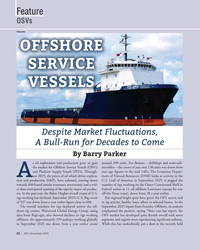 )
November 2025 - Marine News page: 22
)
November 2025 - Marine News page: 22(OSVs) mersibles – the count of just over 130 units was down from and Platform Supply Vessels (PSVs). Through- year ago ? gures in the mid 140’s. The Louisiana Depart- A out 2025, the prices of oil which drives explora- ment of Natural Resources (DNR) looks at activity in the tion and production (E&P),
-
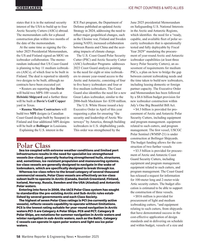 )
November 2025 - Maritime Reporter and Engineering News page: 58
)
November 2025 - Maritime Reporter and Engineering News page: 58Finland and four additional MPI designs terways” by America, through building and program management. equipment will be built at Bollinger in Louisiana. icebreakers in U.S. shipbuilding yards. related to such cutters, and program Explaining the U.S. interest in the This order was strengthened
-
 )
September 2025 - Marine News page: 41
)
September 2025 - Marine News page: 41selected Incat Crowther to design a new, hybrid electric tour vessel for the port’s Houston Ship Channel tours. Incat Crowther will partner with Louisiana- based shipbuilder Breaux Brothers on the project, meaning the new vessel will be both designed and built in the U.S. The new 73-ft. vessel will
-
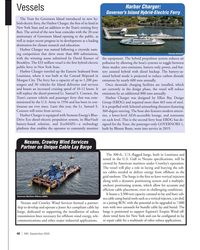 )
September 2025 - Marine News page: 40
)
September 2025 - Marine News page: 40, battery-only power, and bat- Harbor Charger traveled up the Eastern Seaboard from tery assisted hybrid with diesel backup. The battery-as- Louisiana, where it was built at the Conrad Shipyard in sisted hybrid mode is projected to reduce carbon dioxide Morgan City. The ferry has a capacity of
-
 )
September 2025 - Marine News page: 36
)
September 2025 - Marine News page: 36vessels have a length overall of Electri? cation Projects Across the Country 409.5 ft. with an 83.2-ft. beam and a hull depth of 24.5 In Louisiana, electri? cation is also on the way. ft.. They will be certi? ed to transport 160 standard-sized A 1964-built vehicle/passenger ferry, CAMERON
-
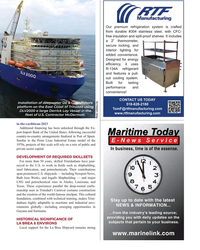 )
August 2025 - Maritime Reporter and Engineering News page: 35
)
August 2025 - Maritime Reporter and Engineering News page: 35span prominent U.S. shipyards — including Newport News, Bath Iron Works, and Ingalls Shipbuilding — and major LNG and petrochemical sites in Alaska, Louisiana, and Texas. These experiences parallel the deep-rooted crafts- manship seen in Trinidad’s Carnival costume construction and the creation of the
-
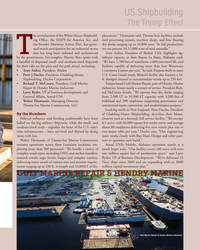 )
July 2025 - Marine News page: 35
)
July 2025 - Marine News page: 35with Ray Hunt Design and other part- Walter Thomassie of Thoma-Sea Marine Constructors ners to optimize each build.” oversees operations across three Louisiana locations, em- Austal USA’s Mobile, Alabama operation stands at a ploying more than 500 personnel. “We handle a variety of much larger scale. “Our
-
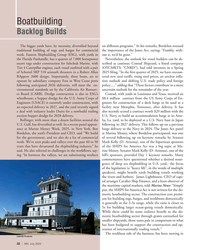 )
July 2025 - Marine News page: 32
)
July 2025 - Marine News page: 32California Air Resourc- uncertain outlook for the remainder of the year. es Board (CARB). Dredge construction is also in ESG’s Conrad, with yards in Louisiana and Texas, received an wheelhouse; a hopper dredge for the U.S. Army Corps of $8.4 million contract from the US Army Corps of En- Engineers (USACE)
-
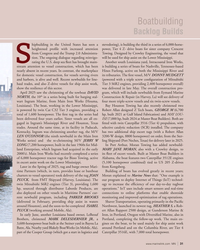 )
July 2025 - Marine News page: 31
)
July 2025 - Marine News page: 31dialogue regarding reinvigo- will be used for ship assist on the Lower Mississippi. S rating the U.S. deep sea ? eet has brought main- Another south Louisiana yard, Intracoastal Iron Works, stream attention to vessel construction, which has been is building a series of boats for Nashville, Tennessee-based
-
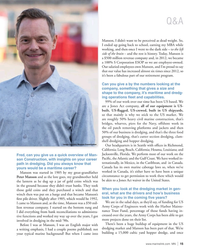 )
May 2025 - Marine News page: 15
)
May 2025 - Marine News page: 15hopper dredging. Image courtesy Manson Construction Our headquarters is in Seattle with of? ces in Richmond, California; Long Beach, California; Houma, Louisiana; and Jacksonville, Florida. We perform most of our work on the Fred, can you give us a quick overview of Man- Paci? c, the Atlantic and the Gulf
-
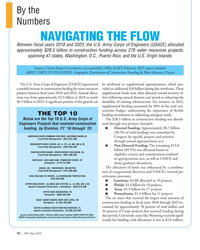 )
May 2025 - Marine News page: 10
)
May 2025 - Marine News page: 10,000 tion of congressional directives and USACE’s internal pri- NEW ORLEANS TO VENICE, LA (HURRICANE PROTECTION) oritization processes: $783,000,000 ? Louisiana: $3.8B allocated to 19 projects. UPPER MISS RIVER - ILLINOIS WW SYSTEM, IL, IA, MN, MO & WI ? Florida: $3.3 billion for 18 projects,. Aquatic Ecosystem
-
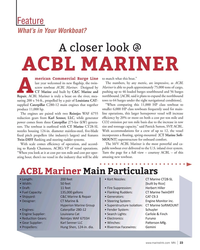 )
March 2025 - Marine News page: 23
)
March 2025 - Marine News page: 23, ACBL Mariner is truly a beast on the river, mea- northbound. [ACBL said it plans to expand the northbound suring 200 x 54-ft., propelled by a pair of Louisiana CAT- tows to 64 barges under the right navigational conditions]. supplied Caterpillar C280-12 main engines that together “When comparing this 11
-
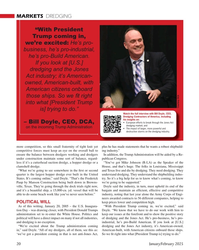 )
January 2025 - Marine Technology Reporter page: 20
)
January 2025 - Marine Technology Reporter page: 20suction dredge, a hopper dredge or a “You’ve got Mike Johnson (R-LA) as the Speaker of the clamshell dredge. House, and that’s huge. The folks in Louisiana, Mississippi “What we’re going to see somewhere in the ? rst or second and Texas live and die by dredging. They need dredging. They quarter is
-
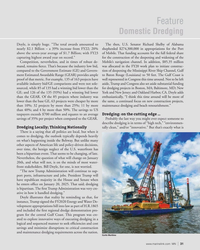 )
January 2025 - Marine News page: 31
)
January 2025 - Marine News page: 31(GE) and Govern- tion of deepening the Mississippi River Ship Channel, Gulf ment Estimated Awardable Range (GEAR) provides ample to Baton Rouge (Louisiana) to 50 feet. The Gulf Coast is proof of that metric. For example, 135 of 163 projects have well represented in Congress this time around. Not to
-
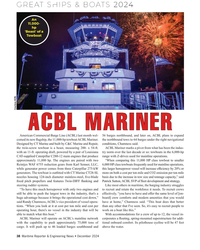 )
December 2024 - Maritime Reporter and Engineering News page: 38
)
December 2024 - Maritime Reporter and Engineering News page: 38is a beast, measuring 200- x 54-ft. ACBL Mariner marks a pivot from what has been the indus- with an 11-ft. operating draft, powered by a pair of Louisiana try norm over the last decade or so: towboats in the 6,000-hp CAT-supplied Caterpillar C280-12 main engines that produce range with Z-drives used
-
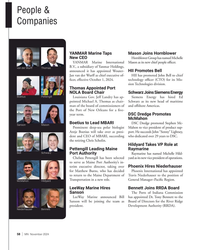 )
November 2024 - Marine News page: 58
)
November 2024 - Marine News page: 58of? cer (CTO) for its Mis- sion Technologies division. Thomas Appointed Port NOLA Board Chair Schwarz Joins Siemens Energy Boetius Pettengill Louisiana Gov. Jeff Landry has ap- Siemens Energy has hired Ed pointed Michael A. Thomas as chair- Schwarz as its new head of maritime man of the board of
-
 )
November 2024 - Marine News page: 48
)
November 2024 - Marine News page: 48and propul- vessel was designed by the The Shearer Group and built by sion system, we have reduced fuel use, minimized emis- Gulf Island Fabricators in Louisiana. sions and made the Esperanza ‘Hope’ Andrade quieter and Stretching 293 feet, the double-ended ferry showcases more comfortable,” said Jana Nythruva
-
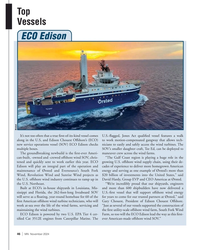 )
November 2024 - Marine News page: 46
)
November 2024 - Marine News page: 46, Group EVP and CEO Americas at Ørsted. the U.S. Northeast. “We’re incredibly proud that our shipyards, engineers Built at ECO’s in-house shipyards in Louisiana, Mis- and more than 600 shipbuilders have now delivered a sissippi and Florida, the 262-foot-long liveaboard SOV U.S.-? rst vessel that will support
-
 )
November 2024 - Marine News page: 40
)
November 2024 - Marine News page: 40operate on The new towboat adds considerable pushing power to ACBL’s mainline network with the capability to push ap- the ACBL ? eet, running on two Louisiana CAT-supplied proximately 75,000 tons of cargo. It will push up to 46 load- Caterpillar C280-12 main engines that together produce ed barges southbound
-
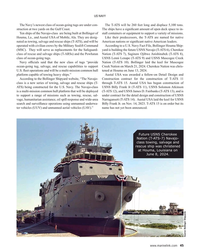 )
November 2024 - Maritime Reporter and Engineering News page: 45
)
November 2024 - Maritime Reporter and Engineering News page: 45(UAV).” name has not yet been announced. Future USNS Cherokee Nation (T-ATS-7) Navajo- class towing, salvage and rescue ship was christened at Houma, Louisiana on June 8, 2024. Source: Bollinger Shipyards www.marinelink.com 45 MR #11 (34-49).indd 45 10/24/2024 12:35:38 P
-
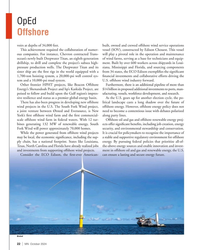 )
October 2024 - Marine News page: 22
)
October 2024 - Marine News page: 22economic signi? cance, including the sup- a stable and supportive regulatory environment for offshore ply chain, has a national footprint. States like Louisiana, energy. By pursuing federal policies that prioritize all-of- Texas, North Carolina and Florida have already realized jobs the-above energy sources
-
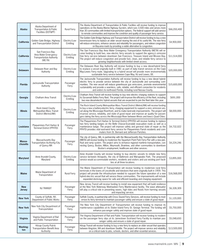 )
October 2024 - Marine News page: 9
)
October 2024 - Marine News page: 9receive funding to replace two ferry landing barges on the Belle Chasse-Scarsdale evacuation route as well as a Plaquemines Port Harbor & Passenger Louisiana maintenance barge. The project will improve safety and gen-eral state of repair as the $4,732,022 Terminal District (PPHTD) Ferry PPHTD provides
-
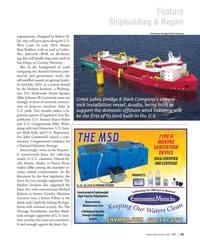 )
August 2024 - Marine News page: 35
)
August 2024 - Marine News page: 35are getting louder. In mid-July 2024, at a session hosted by the Hudson Institute- a Washing- ton, D.C think-tank, House Speaker Mike Johnson (R-Louisiana) came out Great Lakes Dredge & Dock Company’s subsea strongly in favor of renewed construc- rock installation vessel, Acadia, being built to tion
-
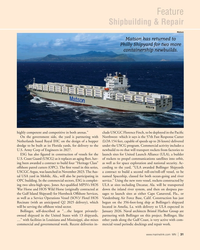 )
August 2024 - Marine News page: 31
)
August 2024 - Marine News page: 31Group are owned shipyard in the United States with 13 shipyards, partnering with Bollinger on this project. Bollinger, like …” with facilities in Louisiana and Mississippi, also mixes other yards along the Gulf Coast, is very active with com- commercial and governmental work. Recent deliveries in- mercial
